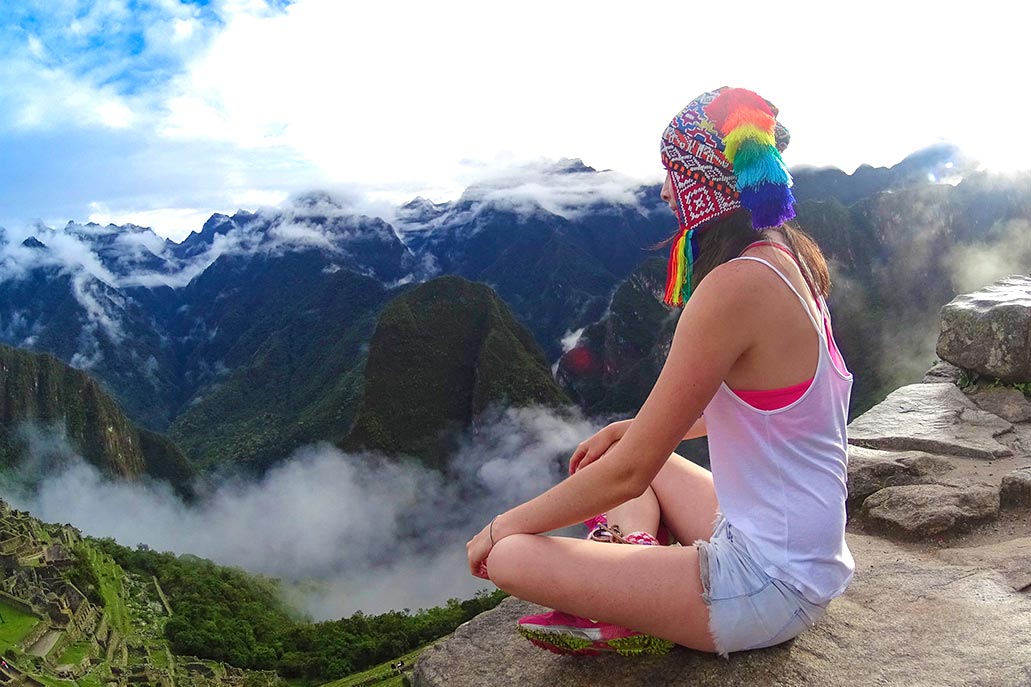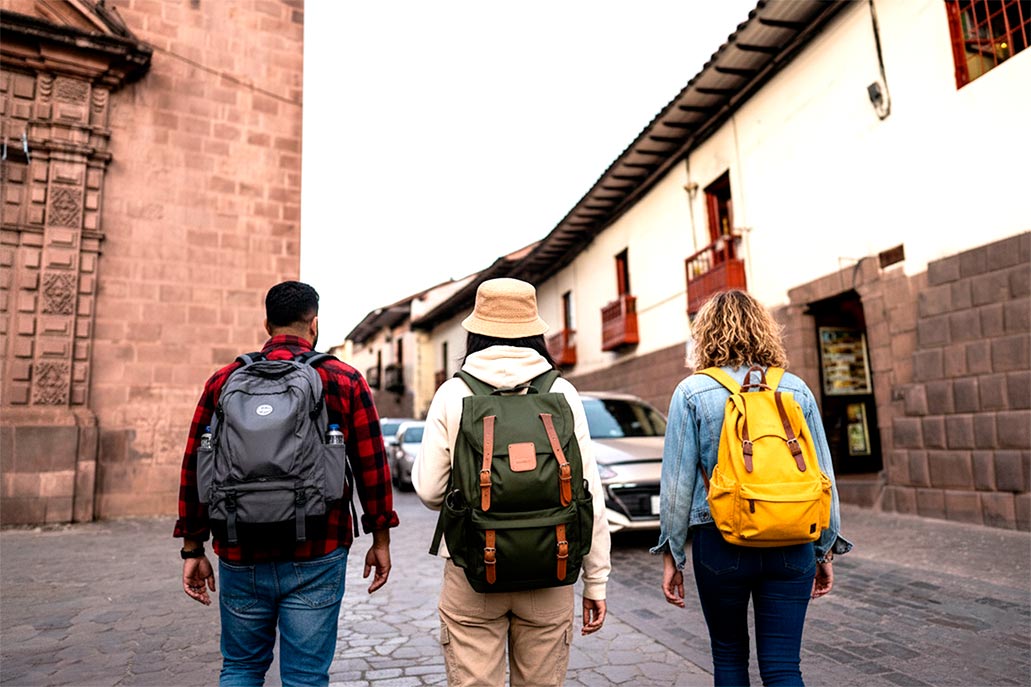Backpacker’s Guide to Peru: Cheap Routes and Authentic Experiences
Being a backpacker is an adventure that seeks authentic experiences without the need for large expenses. Peru’s geographical diversity allows travelers to live countless experiences throughout their journey, choosing those that best suit their style. Discover the most fascinating routes so you can explore Peruvian territory.
Contents
Why is Peru ideal for backpackers?
Peru is the best backpacker destination in South America thanks to its diverse geography. Traveling through this territory allows you, in just a few hours, to go from coastal deserts to the Amazon rainforest or to impressive valleys in the Andean region. Discover more reasons:
- Geographic and cultural variety: When traveling through each region of Peru (coast, highlands, and jungle), you’ll discover a unique identity with traditions and landscapes among the most diverse in the world. On your adventure, you can also visit colonial towns, archaeological sites, and stunning natural areas.
- Accessible transportation: Most interprovincial buses and shared vans cover both long and short routes at very affordable prices. You’ll find options for all budgets and service levels.
- Hospitality: Peruvians are among the warmest and kindest people you’ll meet. You’ll always find the help you need, as well as shelter and food during your journeys.
- Low costs: Most services are inexpensive, depending on the level of quality you’re looking for, but overall prices are lower compared to other South American countries.
- Tourist infrastructure: Peru offers a wide variety of hostels, lodges, and other essential services for your trip. Many towns also offer volunteer programs that allow you to have a more immersive experience.
- Gastronomic variety: Popular menus at local markets cost between 8 and 12 soles, offering you a wide range of dishes — each one a new experience.
Volunteering in Peru
In most towns in Peru, there are homes and social projects that welcome volunteers. This type of exchange offers reciprocal arrangements, where you work a few hours in exchange for food and accommodation. It’s one of the best ways to get to know Peru without spending much.
Best Routes
- Southern Peru
- Arequipa: Known as “the White City,” it boasts impressive attractions. Among the main ones you can visit are: the Colca Canyon, viewpoints of the Misti volcano, and colonial sites like the Santa Catalina Monastery.
- Puno: Located on the shores of Lake Titicaca, this city offers a wide variety of cultural experiences, the main one being community-based tourism on the Uros and Taquile Islands. Puno has direct connections to Arequipa, Cusco, and Bolivia, making it a strategic route to visit.
- Cusco: The main backpacking destination in Peru is Cusco and the Sacred Valley. The recommended route includes the towns of Pisac, Ollantaytambo, Urubamba, and Calca. There are also alternative routes such as Hidroeléctrica, which connects you to the historic sanctuary of Machu Picchu. The diversity of the region allows a deep connection with Andean nature and culture, along with archaeological and colonial remains.
- Central Peru
- Huaraz: It should be your first choice if you want a mountain adventure in Peru. If you’re looking for trekking or climbing, Huaraz is ideal because it’s home to Huascarán National Park. Highlights include Lake 69, the Callejón de Huaylas, Mount Huascarán, and many traditional villages.
- Huancayo: Located in the central highlands, Huancayo offers rural, cultural, and traditional experiences amid stunning landscapes. Highlights include the Wari Willka Sanctuary, Lake Paca, and Cerro de la Libertad.
- Lunahuaná: Only three hours from Lima, this place is ideal for adventure sports like rafting, zip-lining, and cycling. The Cañete River dominates the landscape, and you can also visit local wineries that produce wine and pisco.
- Northern Peru
- Trujillo: Here backpackers can combine archaeological experiences with relaxing beach moments. Highlights include the adobe city of Chan Chan, the Temples of the Sun and the Moon, and beach resorts with a laid-back vibe and unmissable cuisine.
- Máncora: The main beach destination for backpackers in Peru. It has a warm climate and nearby beaches such as Vichayito, Los Órganos, and Punta Sal. It’s an essential stop with a wide range of tourist services to relax to the fullest.
- Peruvian Amazon
- Iquitos: The gateway to the Amazon is Iquitos, where experiences are so diverse that every day will be unforgettable. You can navigate the river, visit native communities, and explore natural reserves. The city offers affordable accommodation and tours for all budgets.
- Tarapoto: One of the most popular Amazon destinations thanks to its good connectivity and affordable prices. Highlights include Lake Sauce, the Ahuashiyacu Waterfalls, and the Quechua village of Lamas — all surrounded by the rich biodiversity of Peru’s jungle region.
- Oxapampa and Pozuzo: These are towns with strong Austro-German influence. Visiting them offers hiking routes alongside waterfalls, coffee plantations, and local communities. You’ll also find the Oxapampa–Asháninka–Yánesha Biosphere Reserve, ideal for an immersive experience in nature and culture.
Ideal Backpacking Itinerary Through Peru
Suggested Itinerary by Regions of Peru | ||||
|---|---|---|---|---|
| Travel Stage | Suggested Route | Main Destinations | What to Experience on Each Leg | Estimated Duration |
| Northern Coast | Tumbes → Máncora → Trujillo | Máncora, Vichayito, Trujillo, Chan Chan | Enjoy the warm weather and beaches, go surfing, and explore pre-Inca history at Chan Chan and the Temples of the Sun and the Moon. | 5 – 7 days |
| Central Coast and Highlands | Lima → Lunahuaná → Huaraz → Huancayo | Lunahuaná, Huaraz, Huancayo | Adventure with rafting and cycling in Lunahuaná, then trekking among snowy peaks and lagoons in Huaraz, and finally cultural tours in Huancayo. | 6 – 8 days |
| Southern Andes | Arequipa → Puno → Cusco | Arequipa, Colca Canyon, Lake Titicaca, Cusco, Sacred Valley, Machu Picchu | Stunning landscapes, colonial towns, and archaeology. Stay with local families, connect with Titicaca communities, and end your journey at the wonder of Machu Picchu. | 8 – 10 days |
| Peruvian Jungle | Cusco → Tarapoto → Iquitos (optional) → Oxapampa | Tarapoto, Laguna Azul, Iquitos, Oxapampa, Pozuzo | Immerse yourself in the Amazon: waterfalls, canoe routes, virgin rainforest, and native communities. Ideal for volunteering or eco-friendly experiences. | 5 – 8 days |
Tips for Backpackers
- During the rainy season (November to March), we recommend visiting the routes along the coastal and jungle regions.
- The dry season (April to October) is ideal for exploring the highlands and hiking through dreamlike mountain landscapes.
- Spend the night in family homes or through community tourism programs to better understand the lifestyle of the local people.
- Take part in traditional activities such as handicraft, farming, and cooking workshops.
- Travel to magical towns to experience local festivals like the Virgen del Carmen (July, Paucartambo) or the San Juan Festival (June, Amazon region).
- Try traditional dishes in every region you visit — at local markets you can find options like pachamanca, chiriuchu, ceviche, juane, and many more from the world’s best cuisine.
- During your backpacking trip, support community projects by joining volunteer programs — you’ll learn while helping others.
- Always respect local customs and nature during your trip.
Frequently Asked Questions
- What is the best time to travel around Peru as a backpacker?
The dry season, between April and October, is ideal for exploring the highlands and hiking. If you travel between November and March, we recommend focusing on the coast and jungle, where the weather is warmer and there’s less rain.
- Is it safe to travel alone in Peru?
Yes, Peru is a welcoming country and travelers usually feel safe. We only recommend taking basic precautions: watch your belongings, avoid poorly lit streets at night, and use official transportation.
- What route do you recommend if I have little time?
If you have one or two weeks, the best option is southern Peru: Arequipa, Puno, and Cusco. It combines nature, culture, and history — all with good connectivity and affordable prices.
- Do I need to speak Spanish to travel around Peru?
It’s not mandatory, but it helps a lot. In tourist areas, many people understand basic English. Still, learning a few Spanish phrases will help you connect better with locals and enjoy your trip more.
- How can I travel between cities without spending much?
The best option is to take interprovincial buses. Many companies offer long routes at low prices, and shared vans (colectivos) are available for shorter trips. You can also take night buses to save on accommodation.
- Where can I stay if I’m traveling on a budget?
In almost every city and town, you’ll find hostels, lodges, and family homes offering both private and shared rooms. Many rural areas also offer accommodation through community tourism or volunteer programs.
- Where can I eat cheaply?
Peruvian cuisine is among the best in the world. You can eat very well in local markets, where full menus are affordable and delicious. Each region has unique dishes that are worth trying.
- What destinations shouldn’t I miss as a backpacker?
It depends on the type of experience you’re looking for. If you love mountains, Huaraz is a must. For cultural routes, Cusco and Puno. For beaches and relaxation, Máncora. For pure nature, Iquitos or Tarapoto.
- Can I volunteer during my trip?
Yes, many towns offer volunteer opportunities in activities such as farming or teaching. It’s a great way to cut costs and have a more immersive experience with local communities.
- How can I travel responsibly?
Respect local customs, avoid leaving waste, buy handicrafts directly from artisans, and choose sustainable services. Being a backpacker also means taking care of the environment and appreciating every culture that welcomes you.
By Machupicchu Terra – Last updated, November 10, 2025


